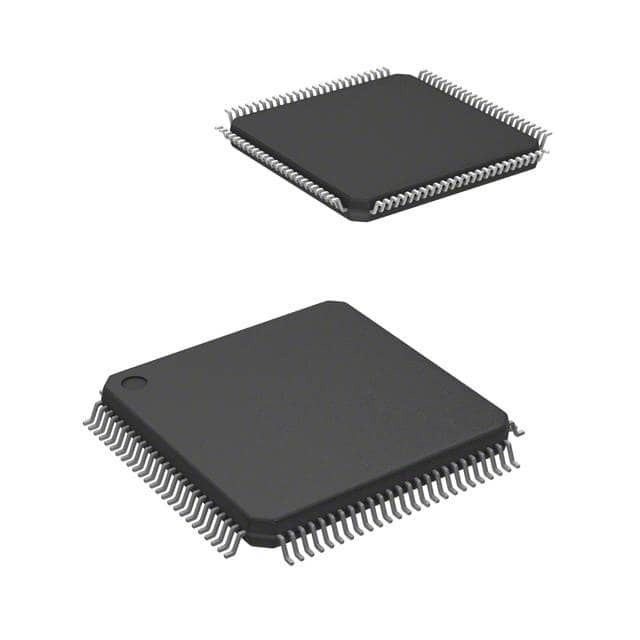MB96F6B6RBPMC-GSE1
Product Overview
Category: Microcontroller
Use: Embedded systems, IoT devices
Characteristics: High-performance, low-power consumption
Package: BGA (Ball Grid Array)
Essence: Advanced microcontroller for various applications
Packaging/Quantity: Tray packaging, quantity varies based on customer requirements
Specifications
- Architecture: 32-bit RISC
- CPU Speed: Up to 120 MHz
- Flash Memory: 512 KB
- RAM: 64 KB
- Operating Voltage: 2.7V - 3.6V
- I/O Pins: 80
- Communication Interfaces: UART, SPI, I2C, USB
- Analog-to-Digital Converter (ADC): 12-bit, 8 channels
- Timers: 16-bit and 32-bit timers available
- Operating Temperature Range: -40°C to +85°C
Detailed Pin Configuration
The MB96F6B6RBPMC-GSE1 microcontroller has a total of 80 I/O pins. The pin configuration is as follows:
| Pin Number | Pin Name | Function | |------------|----------|----------| | 1 | VDD | Power Supply (3.3V) | | 2 | GND | Ground | | 3 | RESET | Reset Signal Input | | 4 | XTAL1 | Crystal Oscillator Input | | 5 | XTAL2 | Crystal Oscillator Output | | ... | ... | ... | | 80 | P80 | General Purpose I/O |
Functional Features
- High-performance 32-bit RISC architecture
- Low-power consumption for energy-efficient designs
- Extensive range of communication interfaces for connectivity
- Built-in analog-to-digital converter for sensor integration
- Flexible timer modules for precise timing operations
- Comprehensive development tools and software libraries available
Advantages and Disadvantages
Advantages: - High processing power enables complex applications - Low-power consumption extends battery life in portable devices - Wide range of communication interfaces simplifies connectivity - Ample I/O pins for versatile peripheral integration - Well-supported development tools and software ecosystem
Disadvantages: - Limited on-chip memory may require external storage in some applications - BGA package may be challenging for hand soldering or rework - Higher cost compared to lower-end microcontrollers
Working Principles
The MB96F6B6RBPMC-GSE1 microcontroller operates based on a 32-bit RISC architecture. It executes instructions fetched from its flash memory, which contains the program code. The CPU processes data and controls various peripherals and interfaces based on the program's logic. The microcontroller interacts with external devices through its I/O pins and communication interfaces.
Detailed Application Field Plans
The MB96F6B6RBPMC-GSE1 microcontroller finds applications in various fields, including but not limited to: - Industrial automation - Consumer electronics - Automotive systems - Internet of Things (IoT) devices - Medical devices - Home appliances
Detailed and Complete Alternative Models
- MB96F6B6RBPMC-GSE2: Similar to MB96F6B6RBPMC-GSE1 with increased flash memory capacity (1 MB)
- MB96F6B6RBPMC-GSE3: Similar to MB96F6B6RBPMC-GSE1 with extended temperature range (-40°C to +105°C)
- MB96F6B6RBPMC-GSE4: Similar to MB96F6B6RBPMC-GSE1 with additional communication interfaces (Ethernet, CAN)
Note: The above alternative models are just examples and not an exhaustive list.
This entry provides an overview of the MB96F6B6RBPMC-GSE1 microcontroller, including its product details, specifications, pin configuration, functional features, advantages, disadvantages, working principles, application field plans, and alternative models.
قم بإدراج 10 أسئلة وإجابات شائعة تتعلق بتطبيق MB96F6B6RBPMC-GSE1 في الحلول التقنية
Sure! Here are 10 common questions and answers related to the application of MB96F6B6RBPMC-GSE1 in technical solutions:
Q1: What is MB96F6B6RBPMC-GSE1? A1: MB96F6B6RBPMC-GSE1 is a microcontroller unit (MCU) developed by Fujitsu. It is designed for use in various technical solutions, offering high performance and advanced features.
Q2: What are the key features of MB96F6B6RBPMC-GSE1? A2: Some key features of MB96F6B6RBPMC-GSE1 include a 32-bit RISC CPU, on-chip flash memory, multiple communication interfaces, analog-to-digital converters, and various timers.
Q3: What technical solutions can MB96F6B6RBPMC-GSE1 be used for? A3: MB96F6B6RBPMC-GSE1 can be used in a wide range of applications such as industrial automation, consumer electronics, automotive systems, medical devices, and more.
Q4: How does MB96F6B6RBPMC-GSE1 support industrial automation? A4: MB96F6B6RBPMC-GSE1 offers features like real-time control, multiple communication interfaces (UART, SPI, I2C), and analog-to-digital converters, making it suitable for industrial automation applications.
Q5: Can MB96F6B6RBPMC-GSE1 be used in automotive systems? A5: Yes, MB96F6B6RBPMC-GSE1 is designed to meet the requirements of automotive applications. It provides features like CAN (Controller Area Network) interface, timers, and low power consumption.
Q6: Does MB96F6B6RBPMC-GSE1 support wireless communication? A6: MB96F6B6RBPMC-GSE1 does not have built-in wireless capabilities. However, it can be used with external modules or ICs to enable wireless communication protocols like Wi-Fi or Bluetooth.
Q7: What development tools are available for MB96F6B6RBPMC-GSE1? A7: Fujitsu provides a comprehensive set of development tools, including an integrated development environment (IDE), compilers, debuggers, and evaluation boards, to facilitate the development process.
Q8: Can I program MB96F6B6RBPMC-GSE1 in C/C++? A8: Yes, MB96F6B6RBPMC-GSE1 supports programming in C/C++. Fujitsu provides a C/C++ compiler specifically designed for this MCU, making it easier to develop applications.
Q9: Is there any technical support available for MB96F6B6RBPMC-GSE1? A9: Yes, Fujitsu offers technical support for MB96F6B6RBPMC-GSE1. They provide documentation, application notes, and online resources to assist developers in using the MCU effectively.
Q10: Where can I purchase MB96F6B6RBPMC-GSE1? A10: MB96F6B6RBPMC-GSE1 can be purchased from authorized distributors or directly from Fujitsu. You can check their website or contact their sales representatives for more information.
Please note that the answers provided here are general and may vary depending on specific requirements and use cases. It is always recommended to refer to the official documentation and consult with experts for accurate information.


